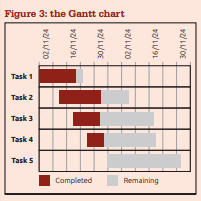
To create a Gantt chart, list the steps required to complete a project and estimate the time required for each step. Then list the steps down the side of the chart and the time intervals along the bottom or top. Draw a line across the chart, indicating how long each step will take. Draw your first line at your start date. The final step will have a line that ends at your planned completion date. In the diagram below, the project has five key blocks of work over several weeks.
Often, key blocks of work will overlap and can be taken forward together, as in the diagram. It is important, however, to identify blocks of work that require a previous step to be completed in order for the next step to start, as these can be key pinch points in a project.
Having completed your chart, your next question is: Who is going to do each step? When assigning tasks to members of your team, be sure to consider these factors:
- Will Who wants to do it?
- Skill Who has the best skills for the task and will work well with everyone else?
- Availability Who is available to do it?
Put your plan into action
As we all know, planning is one thing; delivering is another. Having developed your plan, the key to reaching your goals on time is to track progress carefully and stick to the agreed tasks and objectives as closely as possible.
Review the progress of activities against your plan regularly. At appropriate review points, confirm the validity of the plan and adjust it if necessary. Communicate success regularly to everyone in the project team, but don’t gloss over poor performance or lack of progress. Keep team members and other stakeholders fully informed about progress and the achievement of significant milestones. Ensure that you keep on track and on budget.
Looking back: evaluation
At the end of any project, successful or otherwise, hold a review with the team. You need to understand what happened and why, both good and bad.
Reflect on mistakes and failures positively, objectively and without allocating personal blame. Reflect on successes gratefully and realistically. Write a short review report, where appropriate, so that you log what you have learned. You may also consider using this as part of your continuing professional development. Make observations and recommendations about follow-up issues and priorities.
So, is project management an art or a science? In truth, it’s probably a bit of both. There is definitely a fair amount of science and a comprehensive set of tools and techniques. However, the art lies in the people elements of project management, and this is where the real challenges and opportunities lie.
